This week, we find out what lies beyond the limits of our Universe as we discuss multiverses, higher dimensions, string theory and supersymmetry. We find out how these ideas develop from basic principles and how the LHC can help to confirm, or refute, their existence. In the news, how quartz creates mountain ranges, progesterone excites sperm, and why birds can't help but fly into things. Plus, Meera and Dave find out how to engineer electrons to travel close to the speed of light, and Simon Singh explains how to discover the distance to a far away star.
In this episode

02:02 - How Quartz Sculpts Continents
How Quartz Sculpts Continents
The mineral quartz might hold the key to why continental plates consistently deform in certain regions, a puzzle that's remained hard to answer despite revolutions in our understanding of plate tectonics.
Publishing in Nature, Anthony Lowry and Marta Pérez-Gussinyé use data from the EarthScope Transportable Array, a programme that is steadily measuring seismic activity across the United States, along with gravity and heat flow data, to estimate the relative proportion of quartz in the crust and look for geographic variation.
 Their research took the relatively novel approach of mapping the ratio between pressure waves (vp) - longitudinal sound waves travelling through the crust, and shear waves (vs) - transverse waves that make the crust move like ripples on a pond. This ratio is not a measure used often in research, as it can be inaccurate and is altered by a number of other factors, such as crust thickness. To iron out these inaccuracies, they combined the ratio values with established data from gravity surveys and estimates of heat flow.
Their research took the relatively novel approach of mapping the ratio between pressure waves (vp) - longitudinal sound waves travelling through the crust, and shear waves (vs) - transverse waves that make the crust move like ripples on a pond. This ratio is not a measure used often in research, as it can be inaccurate and is altered by a number of other factors, such as crust thickness. To iron out these inaccuracies, they combined the ratio values with established data from gravity surveys and estimates of heat flow.
The authors argue that a low vp to vs ratio, less than 1.8, correlates to high concentrations of quartz in the crust, and that as quartz is fragile and prone to flow at the temperatures found at depth, this creates weak zones in the crust. Once these regions of weakness establish a deformation zone, this encourages further weakening processes such as the ingress of water and increased heat flow. This dynamic feedback system would ensure that the crust consistently deforms in regions of high quartz, and could even contribute to a weakening of the mantle layer below the crust, further ensuring a zone of weakness is maintained over many millions of years.
Not only could this model elucidate the role of quartz in making mountain ranges, but it could also help to explain some of the more unusual types of earthquake - those that occur in the middle of continental plates, where there is little or no evidence of the fault lines we associate with the more familiar and better understood earthquakes.
This study only observes an area of the Western United States, but the authors intend to keep monitoring the data as EarthScope moves east, eventually measuring activity across the entire country at 70km intervals. Looking at geologically active regions across the world could give us an even better idea about the role of quartz in sculpting our continents.
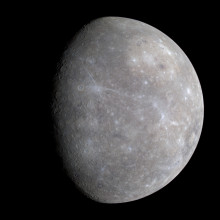
04:39 - MESSENGER Orbits Mercury
MESSENGER Orbits Mercury
This week, news that MESSENGER has become the first space probe ever to be placed into orbit around the planet Mercury has been widely reported. This marks a historic milestone in our exploration of the Solar System, thirty years after the Voyager probes returned superb images of its outer planets, Jupiter, Saturn, Uranus and Neptune. Whilst our understanding of the other planets has steadily increased, Mercury has always remained an elusive planet.
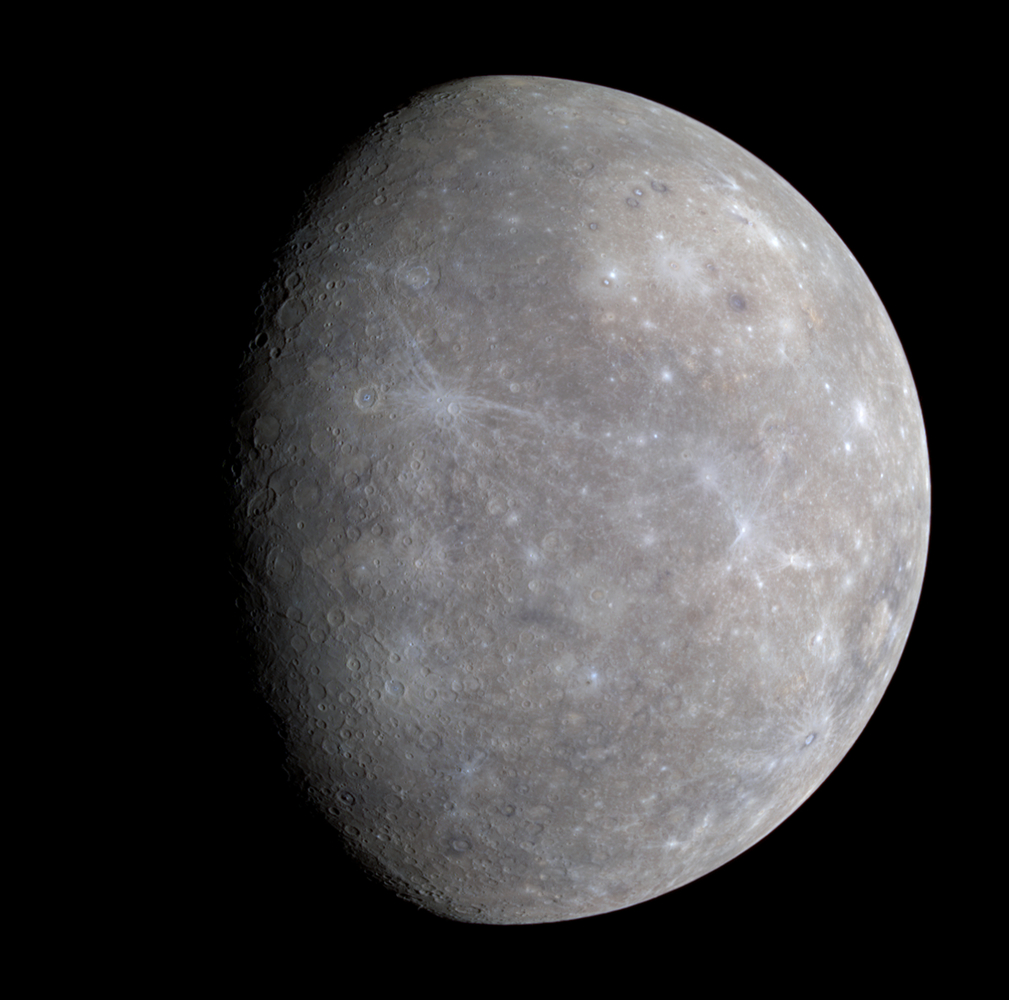 The problem is that it's very difficult to put a spacecraft into orbit about Mercury, because it's so close to the Sun. Any probe sent from Earth has to swoop in towards the Sun, and the effect is rather like rolling down a hill: the probe ends up travelling so fast at the bottom of the hill, when it gets to Mercury, that it shoots past the planet rather than going into orbit.
The problem is that it's very difficult to put a spacecraft into orbit about Mercury, because it's so close to the Sun. Any probe sent from Earth has to swoop in towards the Sun, and the effect is rather like rolling down a hill: the probe ends up travelling so fast at the bottom of the hill, when it gets to Mercury, that it shoots past the planet rather than going into orbit.
The only spacecraft to have made that journey before MESSENGER was Mariner 10 in 1974, which didn't go into orbit and was only able to map one side of the planet as it flew past. MESSENGER has been able to map the other side of the planet, meaning that for the first time, we now have complete maps of the surfaces of all of the planets.
Mercury is fascinating because it's one of the four rocky planets in the Solar System. All four of them appear to have begun from very similar starting points, but to have evolved down very different paths. The Earth, of course, has turned out to be well suited for life. Mars has no magnetic field and a very thin atmosphere, exposing its surface to the Sun's ultraviolet and ionising radiation. Venus' thick atmosphere of CO2 has lead to a runaway greenhouse effect and surface temperatures of 480oC.
Mercury is the twin that we know rather little about. It actually has a fairly strong magnetic field, protecting its surface from the worst of the Sun's radiation, but also suggesting that it has a surprisingly large iron core at its centre. Current thinking is that it might be an Earth-like planet which lost most of its outer mantle in a violent collision with another planet, leaving only the core with a thin outer layer. We will undoubtedly learn much more about Mercury's history over the next few years, and that will help us to understand not only our own Solar System, but also what we might expect to find around other stars.
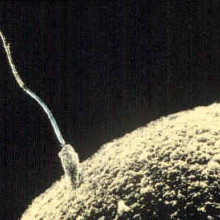
08:10 - How Progesterone Excites Sperm
How Progesterone Excites Sperm
with Dr Steve Publicover, Birmingham University
Ben - Also this week, a pair of papers in the journal Nature have shed some light on how human sperm cells react to the presence of progesterone, and this could lead to a whole new type of contraceptive. Steve Publicover, from the School of Biosciences at the University of Birmingham, penned a "News and Views" article linking the findings of these papers, and explained the implications to me...
Steve - It's been known for more than 20 years now that progesterone, female hormone progesterone - which is produced by the cells that surround the oocyte and they help it to mature and they're still surrounding it after it's been ovulated, so that the egg probably is descending the oviduct, surrounded by a haze of progesterone. So people looked at this ages ago and discovered that progesterone induces a very rapid response in human sperm virtually instantly in as much one can detect. The primary mediator of that seems to be a very sudden rise in intracellular calcium concentration, which is an intracellular message. That was interesting for a number of reasons partly because it clearly had potential significance for fertilisation, and also, because it was not what one we expected steroids, like progesterone, to do. But what we did find out in the meantime was that there is very good reason for thinking progesterone matters in fertilisation. It regulates all sorts of things that we know are really important and at last they've given us a clear precise mechanistic step involved in that whereas up until now, it's been a black box virtually.
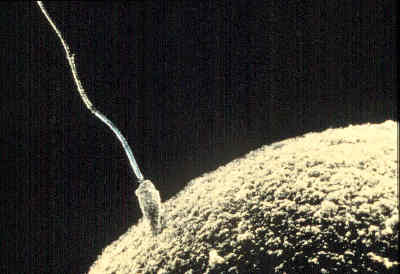 Ben - So the sperm comes into contact with progesterone. What's the next stage? What actually happens?
Ben - So the sperm comes into contact with progesterone. What's the next stage? What actually happens?
Steve - Well what progesterone does is induce an increase in the intracellular concentration of calcium ions which are normally kept in cells very, very low. The cells spend quite a lot of energy mopping calcium up and pumping it out, and keeping it very low. Rises in calcium concentration are used in every cell we know about as a conveyor of information, the size of the rise, and the shape of the rise in terms of its kinetics, things like that. In sperm, certainly, calcium is very, very important for controlling how they swim and controlling a particular secretion event that they do called the acrosome reaction. Progesterone is there as the sperm approach the egg, it may actually be there at very low concentrations in other places as well, but certainly, as the sperm swims right up to the egg, it's going to hit a wall of very high concentrations. It seems to switch on all sorts of things, but progesterone is like a real sort of wake up call. It presses a button, the sperm starts doing things.
Ben - So, the presence of progesterone causes this sudden influx of calcium ions or at least a lack of pumping it out and that obviously is a key stage in changing the behaviour of the sperm cells.
Steve - Yes. We've known that the signal, the changing calcium concentration, was there for ages because there are techniques in measuring concentration in cells which are optical and therefore, they've been quite nice for applying to sperm because the fact that sperm are small and tend to move about a bit, doesn't stop you making the measurements. One of the things that's really key in this, is what's in the Lishko and Kirichok paper, that they developed a technique for applying electrophysiological methods, methods that are used normally in recording the flux of ions across the membranes of nerve cells. They managed to apply it to sperm which are an order of magnitude or so smaller and very, very difficult for various technical reasons to apply these techniques to. They made it work, which meant they could actually measure a flow of ions across the cell membrane. Doing that allowed them to be much more precise to characterise what was going on and to actually identify the fact that progesterone was activating a specific type of protein ion channel in the sperm membrane.
Ben - Does this particular membrane channel have any other role that we're aware of? Is it normally functioning in a very low level and then just gets ramped up by progesterone or is it exclusively for this purpose?
Steve - Up until now, we knew it was there and we knew it was exclusively expressed in sperm. So, the channel is called CatSper because it's a cat-ion channel and it's only expressed in sperm. We knew from various experiments that have also been done on mice that functioning of this channel is very important in regulating the way the sperm swim, and if you produce mice where the gene that codes for this channel has been knocked out, they're still fairly healthy because the only thing that's not going to be working normally is the sperm. The sperm look okay and they can move and they can swim, but they can't undergo a specific change in the way they swim which is called hyperactivation. It's a much more aggressive way of swimming which is switched on as they approach the egg and it seems to be there to provide a kind of added power to get them through the layers that surround the egg in order that they can get right through and do the fusion event. In mice that haven't got this protein, they can't do that change in motility and the result is they're completely sterile.
Ben - So now that we've shed a bit more light on this mechanism, can we start to find ways to use it to our own purposes? Could this be a new contraceptive?
Steve - I think in principle, it certainly could be. It's an enormous opportunity because this is completely specific to sperm and nothing else. If you can produce a drug that hits this channel and nothing else, then you've got a perfect contraceptive. The channel itself belongs to a family which is quite a large one, of voltage operated channels of various sorts, and certainly, some of the other ones are quite similar in their structure. So finding a drug that's really specific to CatSper may turn out to be quite difficult, but I guess in principle, it certainly should be doable. If that could be done, then you could certainly produce a drug that would give you a really nice male contraceptive.
Ben - Steve Publicover from Birmingham University. You can read Steve's news and views article, along with the two papers he discusses, in this week's edition of the journal Nature.

14:14 - Why Birds Crash
Why Birds Crash
Our human eyes may have blinkered us to the way other species see the world, and understanding how birds see could help to reduce the number of fatal collisions with manmade objects such as wind turbines, power cables and even buildings. Now, writing in the journal Ibis, Graham Martin argues that to cut down on deaths, we need to see the world from a bird's perspective.
Sadly, collision with manmade objects seems to account for the largest unintended human cause of avian fatalities worldwide, and many bird species are prone to collisions with structures that appear very conspicuous to us. For example, behavioural observations have shown that White-tailed Sea Eagles in Norway show no tendency to avoid wind turbine blades, simply treating them as if they were invisible.
We know that birds have very good vision - with some species able to pick out fast moving prey from incredible distances, and some species are incredibly dynamic on the wing, able to change direction and speed with apparent ease. So why should objects so obvious to us pose such a problem to birds?
Although some research has looked at collisions from the perspective of flight behaviour & manoeuvrability, very little has been published on the visual and perceptive aspects of this problem. Assuming that the visibility of an object at a distance is the problem, most collision-reducing measures in the last 30 years have involved marking an object with flags or reflective balls; however the probability of collision still remains high.
It's clear that birds don't see the world in the same way as humans - there are distinct differences in eyeball anatomy, location on the head and how the signals are processed in the bird brain. Martin argues that in order to devise effective strategies, we must develop a sensory framework based around a bird's perception of the world.
We are used to the idea of being able to see directly in front of us - usually in the direction we are travelling, but many birds are adapted for coverage alongside, above and behind the head - this may give a wider field of view, but reduces the region of binocular vision in the direction of travel. This lateral vision may play an important role in the detection of predators and foraging, but comes at the expense of being able to see where they're going! Even the Peregrine Falcon, whose vision is good enough to enable them to pick other birds out of the sky, relies mainly on lateral vision - viewing prey from the side and only switching to front-facing, binocular vision at close range.
So what can be done to reduce collisions? There's no catch-all answer, as what works for one species may be invisible to another, but there are some general principles that might help. Large, high contrast markers that employ movement should be deployed around an obstacle, both on the ground nearby as well as directly in front; redirecting flight paths may be more effective than hazard markers, but above all, understanding more about the specific species at risk, and how they see the world, could help to reduce these accidents.
Would a Mars probe in the Sahara desert detect human civilisation?
Dominic - Well that's a great question because NASA do actually test some of their spacecraft in the New Mexico desert or if they want a really harsh environment, they might try the Atacama Desert at high altitude in Chile. And that's a useful test bed for a couple of reasons: it provides a similar physical environment to what you might find, for example on Mars, and so you can test for practical issues like whether your wheels are going to get clogged up with mud when you drive around on Mars; It also means you can see if you can detect the really quite sparse life forms, the bacteria that you find in the sand of the desert, and the answer is that yes, you can. You really need to draw a distinction between two different objectives that you can have when you're searching for extraterrestrial life. You can either be searching for anything that seems to be alive, so anything from bacteria upwards, or you could be searching for signs of intelligence, searching for intelligent life like ourselves. And you can divide the current search programmes for extraterrestrial life into those two categories. So if you're sending rovers to Mars and looking at soil samples, you're really talking about looking for bacteria rather than looking for little green men. But if you're looking at the signals from radio telescopes to see if you can detect alien television signals perhaps coming from alien planets, then that is looking for intelligence, rather than direct traces of life itself. Having said that, I think if you were to land a rover in the desert, you probably would be able to detect that there was something quite funny going on on this planet because you would smell the air and you would notice it had quite a large oxygen content, and you would wonder where that oxygen was coming from and think that maybe you needed some plants and some photosynthesis to make that oxygen. And you would probably also notice that this planet had quite a lot of radio noise coming from it, from planes, from communication satellites, and of course from radio and television transmitters. So you would think it was quite an odd planet, I think.
Ben - So, the odds are, it would pick up some very tantalising clues of our existence, even if it landed somewhere where there are no humans for hundreds of miles.
Dominic - I think it would, yes.

20:41 - Planet Earth - Carbon Capture and Storage
Planet Earth - Carbon Capture and Storage
with Mike Stephenson, National Centre for Carbon Capture and Storage
Ben - One of the most promising technologies for tackling rising carbon dioxide levels in the atmosphere is known as 'Carbon Capture and Storage'. The idea here is that you pump carbon dioxide from power stations into a rock, rather than into the atmosphere. But you do need to have the right kind of rock. To find out more, Planet Earth Podcast presenter, Richard Hollingham, visited the pub...
Richard - It's the curiously named, Ye Olde Trip to Jerusalem. In the centre of Nottingham, it lays claim to being the oldest inn in England. The pub is built into a sandstone cliff and inside, it feels more like being in a cave than in a pub. A cave with beer. I'm here to meet Mike Stephenson, the Director of the National Centre for Carbon Capture and Storage. Mike, why have we come to the pub?
 Mike - It's a great place to show you how we can use these rocks to actually absorb carbon dioxide. We can take carbon dioxide out of the atmosphere and push it or force it into these rocks. And we think it will probably stay there for a very, very long time.
Mike - It's a great place to show you how we can use these rocks to actually absorb carbon dioxide. We can take carbon dioxide out of the atmosphere and push it or force it into these rocks. And we think it will probably stay there for a very, very long time.
Richard - Now I had this idea in my mind of carbon capture and storage. It was using reservoirs underground, vacant spaces in the rock like tanks that you could inject the carbon dioxide into, but that's not the case?
Mike - No, it's not like that at all. There are very few open spaces if you go down deep into the rock. The pressure is too big to get open space, but what these rocks illustrate quite well is that there are a lot of very small spaces between the particles that make up the rock. So for example if I just show you very quickly, just a demonstration. If you pour a little bit of beer there, be careful not to pour too much on, but if you pour a little bit of beer on the sandstone which is the wall of the pub, what you see is it's all wet and shiny at first, and what you slowly begin to see is the beer is soaking into the rock there.
Richard - It's disappearing very, very quickly, isn't it? And now, it's almost dry, isn't it?
Mike - It's almost dry, yeah.
Richard - I suppose it's like a beach, isn't it? When you step on it, you get the water there then it goes dry very quickly.
Mike - That's right. What you've really got here is that the sandstone itself is made of particles, more or less spherical particles. They're all packed together. They're not packed together perfectly because there are spaces in between and when I'm pouring the beer in, then what's really happening is the water, the beer, is leaking into the wall or soaking into these spaces in between the particles. You can't see them, but there is a huge amount of space inside this sandstone, and that's what we proposed to do, fill it up with carbon dioxide.
Richard - How would you do that? It's very easy to drip a beer or a little bit of wall, it's quite different to inject carbon dioxide.
Mike - If you do it right, you should be able to push it into this rock quite effectively. This has been done for a long, long time. For example in United States, they've been injecting CO2 into rocks for 30 or 40 years. Actually for enhanced oil recovery, that means, squeezing the last bit of oil out of an old oil reservoir. So we know how to do this and we think we could probably store quite a lot of CO2 in this particular rock. This is another reason why this pub is interesting. This Bunter sandstone underlies a lot of the North Sea and the Irish Sea and these are the places where you might put the CO2. So, you're actually looking at the rock that, underneath the North Sea, would be our storage space.
Richard - Now you dribbled the beer on a couple of minutes ago. It's almost disappeared, but some of it has come out. How do you ensure that your carbon dioxide stays there?
Mike - The main thing is to have the right kind of structure that will keep the CO2 in place. CO2 is a buoyant fluid when it gets injected at that depth and it will tend to rise up above the water that's also in the rock. So it'll tend to float up and the key really is to making sure that the rocks above the reservoir or above the sandstone are completely impermeable. So a bit like a damp course in a house. We're talking about a rock layer that stops the CO2 going up any further.
Richard - So when is this going to happen? Are we on the cusp of this technology being available so we start injecting carbon dioxide into these areas?
Mike - The key thing is that although all the three types of technology - this capture which is really a chemical engineering activity, the transport which is putting it through pipes, and the storage or the injection into rocks - All those three things are known about and we've been able to do them for a long, long time separately.
Richard - I guess to clarify this, the capture would be from say, a power station or something like that.
Mike - Yeah, generally, we capture from power stations, but there's no reason why you couldn't capture from a cement work or from an ammonia factory. All of them produce a lot of CO2.
Richard - Okay, so you got all those in place, but...
Mike - But the problem is, that the sheer scale at which we have to do this is something that's daunting and also, putting it together into a system that works where one thing feeds another, not too fast, not too slow, that's a big challenge.
Ben - That was Mike Stephenson, the Director of the National Centre for Carbon Capture and Storage, and he was talking to Planet Earth Podcast Presenter, Richard Hollingham over a pint.
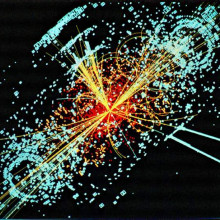
34:49 - Supersymmetry and the LHC
Supersymmetry and the LHC
with Dr Chris Lester, Cambridge University
Ben - Any hypothesis on multiverses will remain just that, a hypothesis, until experimental physicists can find observations to support or refute these ideas. We're joined in the studio now by Dr. Chris Lester. He is a Cambridge University physicist, who also works on the LHC-ATLAS instrument. Thank you ever so much for joining us.
Chris - Thank you.
Ben -
Brian Greene mentioned supersymmetry. So before we go any further, could you just explain what that actually means?
 Chris - Supersymmetry is a fairly old theory. It's been around since the '70s or thereabouts. You could think of it as effectively a bit like when you take matter - we all know about matter - and we're aware also that there's antimatter, it's sort of a reversed copy and the charges are all different again, pluses and minuses, and so on in antimatter. If you could flip all of those things again, and imagine creating another mirror image of the world's particles, but instead of changing the charges, if you change the spins of particles so that the particles that had to be spinning originally aren't and the particles that aren't spinning now, have to be. Then those are your supersymmetric particles and there are various reasons for wanting those, including some of the particles that you get out of that could perhaps make dark matter and things like that, that the astronomers are telling us that we need.
Chris - Supersymmetry is a fairly old theory. It's been around since the '70s or thereabouts. You could think of it as effectively a bit like when you take matter - we all know about matter - and we're aware also that there's antimatter, it's sort of a reversed copy and the charges are all different again, pluses and minuses, and so on in antimatter. If you could flip all of those things again, and imagine creating another mirror image of the world's particles, but instead of changing the charges, if you change the spins of particles so that the particles that had to be spinning originally aren't and the particles that aren't spinning now, have to be. Then those are your supersymmetric particles and there are various reasons for wanting those, including some of the particles that you get out of that could perhaps make dark matter and things like that, that the astronomers are telling us that we need.
Ben - Antimatter originally arose as what looked like an error in the maths. Are we getting something similar with supersymmetry? Is this something that sort of has to be there to make things balance or is this something that is key to the predictions of the theories?
Chris - At the moment, we don't have to accept supersymmetry at all. It may simply not be there. But many of the reasons that people are - or those people who are hoping that it's there - one of the reasons that they want it to be there is certainly because it fixes up a number of problems in the maths they don't like. That sort of thing has been useful in the past and antimatter turned out to be true, whether that's going to be the case for supersymmetry, we don't yet know.
Ben - So, where are we now at the LHC experiments? It obviously had its first run and it's currently cooling down. They'll be switching it on again fairly soon, I think.
Chris - In fact, it turned on again about a week ago.
Ben - Right! I apologise for being late in that case. Sorry, LHC! So it's now back on for its second batch, but what have we got from it so far?
Chris - The first year of data, the data taken in 2010, the machine was effectively finding its feet. Every couple of weeks or so, the people who run the machine and get the collisions were able to make it almost twice as powerful in every two weeks. So, all the data from last year in a sense is almost exclusively the data that was taken in the last couple of weeks of operation. With that data, we've been able to start closing in on the Higg's Boson, we're not yet in a position to say whether it doesn't exist in any particular places, but closing on it; trying to find out whether or not supersymmetry exists, this is the work that I've personally been doing, we've managed to show that quite a lot of the places where people thought supersymmetry might exist, quite a lot of those are simply unlikely to be true! But it could still be hiding in various places. But in a sense with the data that we've taken, the limited data from last year, the Large Hadron Collider has been in some sense, just rediscovering the standard model, getting to the point at which it's about to be able to make even more important and exciting predictions.
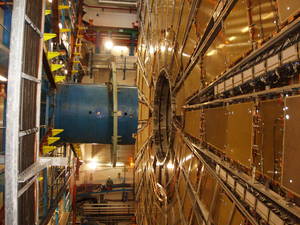 Ben - And specifically, you work on ATLAS. It's very easy to fall into the trap of thinking that the LHC is just one big experiment, but there are actually lots of different detectors on it. Specifically, what is Atlas doing?
Ben - And specifically, you work on ATLAS. It's very easy to fall into the trap of thinking that the LHC is just one big experiment, but there are actually lots of different detectors on it. Specifically, what is Atlas doing?
Chris - Atlas is one of the two general purpose detectors. So as you said, there are four main detectors on the Large Hadron Collider, two of them have specialist roles. ATLAS is trying to basically look for anything - what are the basic building blocks of the universe? We're looking for any particles that we don't currently know about, we're looking to find the Higgs boson, and we're trying to cover all bases really. So, it's a general purpose experiment that is just looking for things that are out there that we're not really sure about, that we don't know exists yet.
Ben - Does this mean that you're getting pulled every which way by different people, demanding your data and interpreting it in different ways? As you said, you'll have theoretical physicist saying, "Well, I can use this data to find these hidden dimensions." You'll have the particle physicists saying, "I'm going to confirm or refute the existence of something very obscure." Do you really get to consider at one particular hypothesis for yourself or are you having to do a very general interpretation of these figures?
Chris - Personally, I do, and most of the people working on ATLAS do get to focus on a fairly narrow area, the area that interests them most. Because quite simply, there are so many people who are working on it, to cover all of those bases, that everyone divides the work amongst themselves. But even so, even in my case where I was chatting to some of the theorists in CERN before our data was released, when you still have to be quite secretive about what's there, so that the competition, don't find out about it and use it. Very often, they're saying "But why aren't you working on this? Why isn't your first paper on supersymmetry ruling out this particular type of supersymmetry or that type?" So yes, there's lots of tensions there, people are intrigued to convince us to work on that particular bit.
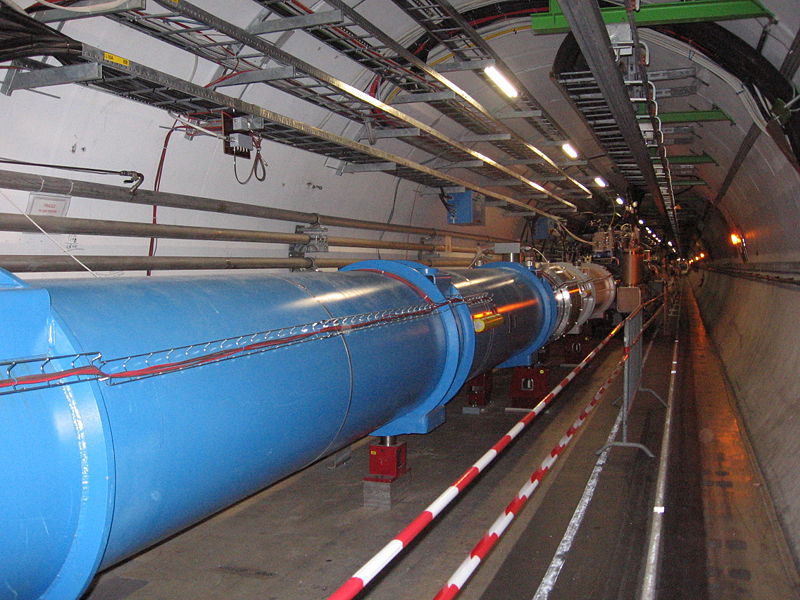 Ben - Have any of the LHC results so far - obviously, it's still early days - has anything actually told us that what we thought was right is actually wrong, rather than making big new discoveries, have we found out that our theories didn't quite stand up?
Ben - Have any of the LHC results so far - obviously, it's still early days - has anything actually told us that what we thought was right is actually wrong, rather than making big new discoveries, have we found out that our theories didn't quite stand up?
Chris - Not that I'm aware of so far. There are some little hints in some places of things where effectively I think the juries are still out and we might be needing to take more data when we look at what's coming on early this year. But I think at the moment, you could still say, the standard model rules okay. Our current ideas of particle physics haven't yet been shown to be completely wrong in any particular area.
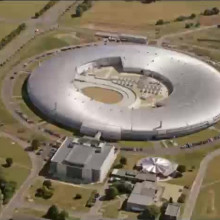
40:39 - Naked Engineering - Synchrotrons
Naked Engineering - Synchrotrons
with Jim Kay, Head o f Engineering, Diamond Synchrotron
Ben - Keeping on the theme of particle accelerators, for this week's Naked Engineering, Meera and Dave have been out to the Diamond synchrotron, that's an electron accelerator, based out in Didcot, Oxfordshire where head of engineering Jim Kay gave them a tour of the facility to see just how electrons can be made to move close to the speed of light using a combination of vacuums, magnets and a few other pieces of engineering...
Jim - The Diamond synchrotron is a large scale science facility comprising three electron accelerators which are used in series to produce electrons which are stored in 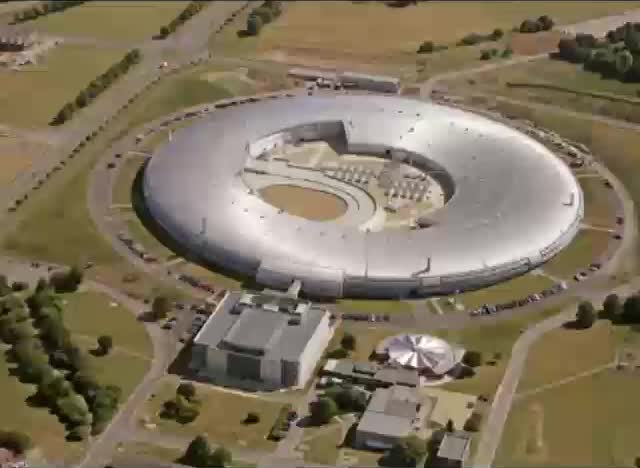 our storage ring at 3,000 million electron volts (MeV) and at that energy, when the electrons are bent in their orbit they produce high energy x-rays. We extract the x-rays in tangential beam lines to the storage ring and conveyor them down to end stations where the scientists have positioned their sample to expose the sample to x-rays, and take data on how the x-rays interact with their samples.
our storage ring at 3,000 million electron volts (MeV) and at that energy, when the electrons are bent in their orbit they produce high energy x-rays. We extract the x-rays in tangential beam lines to the storage ring and conveyor them down to end stations where the scientists have positioned their sample to expose the sample to x-rays, and take data on how the x-rays interact with their samples.
Meera - The storage ring itself is very large. It has a circumference of 560 metres and the electrons are moving very close to the speed of light. So, how firstly do you even get electrons moving that quickly?
Jim - The electrons start the journey in a cathode and in the cathode, we boil electrons off a heated surface in a vacuum, and then attract them towards a positive plate, the anode, which is held at 90,000 volts. We then inject them into a device we call LINAC, a linear accelerator where now, the energy is added to, but by using RF waves. These RF waves are radio frequency waves and this is a different method of giving energy to the electrons, and in the LINAC, we accelerate the electrons now from 100 KeV to 100 MeV - 100 million electron volts.
Dave - So, this is essentially producing waves of electric fields in a chamber, so little bunches of electrons will surf a wave down the chamber and accelerate down the chamber.
Meera - Well we're now within the synchrotron itself, so we're just towards the end of the LINAC, the linear accelerator, towards the booster section of the synchrotron.
Jim - So we're stood in the booster tunnel which you can see is a large concrete vault and in fact here, the walls and roof are 2 meters thick to absorb the harmful radiation that's produced when electrons are circulating and to keep the dose of the outside of the walls no higher than background.
---
Meera - We've now moved away from the booster into the main storage ring which is 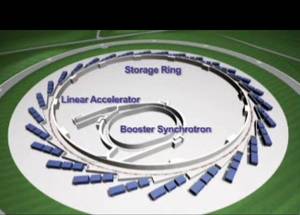 where the electrons move to after the booster section of the synchrotron. We're now next to an insertion device which is actually where the electrons are made into actual x-rays. Jim...
where the electrons move to after the booster section of the synchrotron. We're now next to an insertion device which is actually where the electrons are made into actual x-rays. Jim...
Jim - Basically, the way we produce high energy x-rays is that we expose the electrons to an alternating magnetic field and we produce this by having many permanent magnets which we bring close to the electron beam, and arrange them so that the electrons see an alternating north-south, north-south, north-south field. And as the electrons go through this alternating magnetic field, they wiggle or move side to side and every time a relativistic electron wiggles, it gives off a squirt of x-rays.
Dave - This is a bit like when electrons wiggle up and down an aerial and they give off radio waves, but this is happening far faster, so now, it's x-rays.
Meera - Well this insertion device, it's a very large structure. It's about 3 meters tall, 2 meters or so wide. It's very solid looking...
Jim - This device carries these magnets which we bring very close to the electron beam. The closer we can bring them to the electrons, the stronger the magnetic field, the bigger the kick we can give the electrons. So that's good to produce the high energy x-rays.
Dave - You're talking about the magnets having to be incredibly accurately positioned. Why is accuracy so vital?
Jim - So what we're trying to do is produce a spot of electrons, a focused spot of electrons, 10 microns diameter, so that's a quarter of the diameter of a human hair. At that dimension, so many things can upset the stability of that electron beam. So in terms of stability, we know that at the beam height which is 1.4 metres above the floor, if the temperature in here which are changed by 1 degree C, that beam height would change by more than 20 microns which is more than twice the diameter of the electron 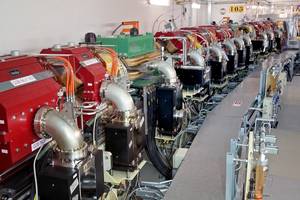 spot size. So we know that to keep the temperature very stable in here is key and hence, you can see all this heating and ventilating duct work providing air at 22 degrees C. You can also see that the electromagnets, these very big red and yellow magnets, which have water cool coils because of the current density that we need to drive these magnets, and the water cooling is also provided at 22 degrees C. And hence, by the air being at 22, the water at 22, we minimise the heat transfer and hence, the contraction and expansion of all these metallic components.
spot size. So we know that to keep the temperature very stable in here is key and hence, you can see all this heating and ventilating duct work providing air at 22 degrees C. You can also see that the electromagnets, these very big red and yellow magnets, which have water cool coils because of the current density that we need to drive these magnets, and the water cooling is also provided at 22 degrees C. And hence, by the air being at 22, the water at 22, we minimise the heat transfer and hence, the contraction and expansion of all these metallic components.
Meera - So stability is clearly a key engineering challenge with regard to Diamond and the minimisation of any movement. At regular intervals along around the storage ring, there are surveying points - maybe every 10 metres - which are, I imagine, just making sure that nothing is moving?
Jim - As you can imagine as we look down the tunnel here, we can see it very quickly curve out of view. But we're trying to align each of these girders carrying these magnets to within 0.1 mm of its neighbour and around the whole of 560 meters circumference, we're trying to align everything within a global cylinder of confusion of 1 mm diameter. In order to do that, we've got a very accurate survey network using some very precise theodolites and a process of automatic target recognition when we carry out a survey, to position these magnets with such high precision.
Meera - Well another factor to consider for the stability is the ground that the synchrotron is on...
Jim - Yes, very true and we've built a very strong floor that carries the accelerator and all the beam lines that are linked to the accelerator. We want to guarantee that the x-rays produced at the focal point of the electrons have the best chance of getting to the sample point, maybe 40 meters or more away, and not lose any definition or be blurred by vibration or by differential settlements. So the floor we've built is 800 mm thick under our feet here and carried, in the whole facility, on over 1500 piles which are 600 mm diameter and penetrating down to 15 meters into the chalk. It's extremely stable and we've used a system called a hydrostatic levelling system where over a 60-meter length, we've been measuring the level of the floor, accurate to a few microns over the last year, and we know now that over 10 meters, our stability has achieved our 10 microns per 10 meters per day stability requirement.
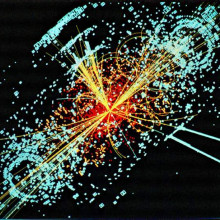
How much progress will we make if we discover the Higgs boson?
We posed this question to Professor Chris Leicester from the University of Cambridge...
Chris - Well, if we do confirm that it exists, it would be an outstanding international achievement from the point of view of people across the world having had to get together and work for more than 40 years on trying to actually track down this one particle.
But, in one sense, if that real number is found, and we learn that the particle is there after all - and many people think that it is - that that would in some sense be perhaps less stunning than looking throughout the lifetime of the Large Hadron Collider, checking all the bases, and then finding out that the Higgs boson didn't exist, which would really put a cat among the pigeons.
So, in a way, there are some people, mischievous people perhaps, who would most prefer that we didn't find Higgs bosons, so long as the machine carries on working and it's a definitive not having found it.
Ben - You said 'put the cat amongst the pigeons.' Are there good alternative hypotheses that would step in to fill the gap or does it really send our current understanding totally into the bin?
Chris - There are competing theories that are trying to step into that void. But the problem perhaps is that none of these have really got a strong following. There are many things we've built on top of the standard model and upon extensions of the standard model which help to explain the universe and the way it works, and there isn't that similar edifice built on top of these other theories.
So there'd be a lot of thinking still to do to make them all work!
Could heavier elements be formed in a massive enough star?
Dominic - Yes, it is quite an awesome thought that all of the heavy elements in the universe were made in the nuclear furnaces inside the centres of stars. So all of the carbon that we're made of and all of the oxygen in the atmosphere was all made in the centres of stars and then blown out of those stars in supernova explosion subsequently to form into the solar system. Now, the more massive a star is, the heavier the elements it makes and the more heavy elements it makes, and the bigger the supernova explosion at the end and the more widely distributed that material is. But in terms of heavy elements that we don't yet know about, what you find is that the heavier an element is, the more unstable that atomic nucleus is, and the more radioactive it is. So for example, uranium is quite a massive atom and that is, of course, radioactive and we use that as a power source. As you move to more and more massive atoms, the life times of those radioactive elements goes down and you start to find that your average decay time is less than a second or perhaps only a millisecond. And so, even if those atoms were formed, they wouldn't last very long and we certainly wouldn't find them in the universe. Ben - Do you think it's likely that we would see evidence of them having existed, maybe the energy from their decay? Dominic - I think some of the atoms which people have been making in the lab as I say, have life times of orders of milliseconds, so that is really so incredibly short, but it would be very difficult to track any signature at all.
Where would extra dimensions reside?
We posed this question to Dr Chris Leicester from the University of Cambridge...
Chris - I think that the thing you have to picture is with a lot of these things, they would fit all around you, every part of your fingernail would have a latitude, a longitude, and a position in some of the extra dimensions, at least in some of the classes of theory. There are others where the extra dimensions only gravity can fit into. In which case, you still only have a latitude and longitude, and nothing else.
Dominic - So if you imagine our 3-dimensional universe as being a sort of sheet in a much higher dimension of universe.
52:32 - How can you determine the distance to a star?
How can you determine the distance to a star?
We posed this question to Author, Physicist and Campaigner, Simon Singh...
The way you do this is by using something called parallax. Now that means that you measure the angle to a star using a telescope and then you move your telescope to a different position and you look for a shift in the angle to the star. The problem is, the stars are so very, very far away, you need to move your telescope a long way in order to get a perceptible shift in angle. A few meters, a few kilometres, a few hundred kilometres just isn't enough. It wasn't until the 19th century that an astronomer, Friedrich Bessel, moved his telescope to the other side of the Sun. He took a measurement in July from the Earth and then he waited six months for the Earth to go right around the other side of the Sun, he took another measurement. Even though the Earth and his telescope had moved such a vast distance, the shifting angles of the star was just 1/6000th of a degree, a tiny shift, but that tiny shift was enough for him to work out the distance to the local stars around us. Now to give you an idea how far away those stars are, it takes about 8 minutes for light from the Sun to reach us on Earth. It takes over 4 years for light from our closest star to reach us. That's how you measure the distances to the stars.
- Previous How Progesterone Stimulates Sperm
- Next Engineering Synchrotrons










Comments
Add a comment